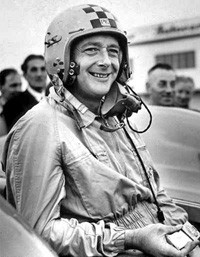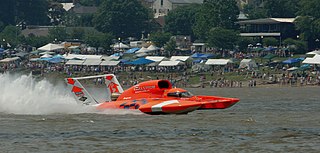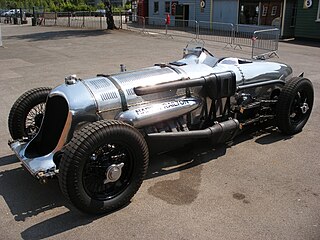
Spirit of Australia is a wooden speed boat built in a Sydney backyard, by Ken Warby, that broke and set the world water speed record on 8 October 1978. [1] [2] [3]

Spirit of Australia is a wooden speed boat built in a Sydney backyard, by Ken Warby, that broke and set the world water speed record on 8 October 1978. [1] [2] [3]
On 8 October 1978, Ken Warby rode the Spirit of Australia on the Tumut River near the Blowering Dam in Australia on opposite direction runs of 492.813 km/h (306.220 mph; 266.098 kn) and 529.412 km/h (328.961 mph; 285.860 kn), [4] for an official record of 511.11 km/h (317.59 mph; 275.98 kn), [5] [6] with a peak speed of 555 km/h (345 mph; 300 kn). [4] It was powered by a Westinghouse J34 jet engine. The engine was developed by the Westinghouse Electric Company in the late 1940s and was used for jet fighters and other aircraft. Spirit of Australia is displayed permanently at the Australian National Maritime Museum in Darling Harbour, Sydney, New South Wales. [7]
Starting in the early 1990s, Warby built a second jet boat, Aussie Spirit powered with a fresh Westinghouse J34, but he never made a record attempt with it. [8] Warby and his son Dave then worked on a new boat, Spirit of Australia II, powered by a Bristol Siddeley Orpheus jet engine taken from an Italian Fiat G.91 fighter. [9] [10] [11] This was completed in December 2004. In 2007 Ken Warby handed over the reins to his son who achieved 314 km/h (195 mph; 170 kn) on a testing run on Blowering Lake in 2018. [12] As of 22 May 2021 the team are still modifying the design. [13]

Donald Malcolm Campbell, was a British speed record breaker who broke eight absolute world speed records on water and on land in the 1950s and 1960s. He remains the only person to set both world land and water speed records in the same year (1964). He died during a water speed record attempt at Coniston Water in the Lake District, England.

The land speed record (LSR) or absolute land speed record is the highest speed achieved by a person using a vehicle on land. By a 1964 agreement between the Fédération Internationale de l'Automobile (FIA) and Fédération Internationale de Motocyclisme (FIM), respective governing bodies for racing in automobiles and motorcycles, both bodies recognise as the absolute LSR whatever is the highest speed record achieved across any of their various categories. While the three-wheeled Spirit of America set an FIM-validated LSR in 1963, all subsequent LSRs are by vehicles in FIA Category C in either class JE or class RT.

Craig Breedlove was an American professional race car driver and a five-time world land speed record holder. He was the first person in history to reach 500 mph (800 km/h), and 600 mph (970 km/h), using several turbojet-powered vehicles, all named Spirit of America.

The McDonnell XF-88 Voodoo was a long-range, twinjet fighter aircraft with swept wings designed for the United States Air Force. Although it never entered production, its design was adapted for the subsequent supersonic F-101 Voodoo.

The Douglas D-558-2 Skyrocket is a rocket and jet-powered research supersonic aircraft built by the Douglas Aircraft Company for the United States Navy. On 20 November 1953, shortly before the 50th anniversary of powered flight, Scott Crossfield piloted the Skyrocket to Mach 2, or more than 1,290 mph (2076 km/h), the first time an aircraft had exceeded twice the speed of sound.

A hydroplane is a fast motorboat, where the hull shape is such that at speed, the weight of the boat is supported by planing forces, rather than simple buoyancy.

The Convair F2Y Sea Dart was an American seaplane fighter aircraft that rode on twin hydro-skis during takeoff and landing. It flew only as a prototype, and never entered mass production. It is the only seaplane to have exceeded the speed of sound.

The Ryan FR Fireball was an American mixed-power fighter aircraft designed by Ryan Aeronautical for the United States Navy during World War II. It was the Navy's first aircraft with a jet engine. Only 66 aircraft were built before Japan surrendered in August 1945. The FR-1 Fireball equipped a single squadron before the war's end, but did not see combat. The aircraft ultimately proved to lack the structural strength required for operations aboard aircraft carriers and was withdrawn in mid-1947.

The world unlimited Water Speed Record is the officially recognised fastest speed achieved by a water-borne vehicle, irrespective of propulsion method. The current unlimited record is 511.11 km/h (317.59 mph), achieved by Australian Ken Warby in the Spirit of Australia in 1978.

Ken Warby was an Australian motorboat racer, who at his death held the water speed record of 275.97 knots, set on Blowering Dam on 8 October 1978.

The Blowering Dam is a major ungated rock fill with clay core embankment dam with concrete chute spillway impounding a reservoir under the same name. It is located on the Tumut River upstream of Tumut in the Snowy Mountains region of New South Wales, Australia. Purposes for the dam include flood mitigation, hydro-power, irrigation, water supply and conservation. The dam is part of the Snowy Mountains Scheme, a vast hydroelectricity and irrigation complex constructed in south-east Australia between 1949 and 1974 and now run by Snowy Hydro.
Rosco McGlashan OAM is an Australian drag racing record-holder, who currently holds the Australian land speed record at 500 mph (802.6 km/h). This record was set on the 27 March 1994 on the dry salt flats of Lake Gairdner, South Australia, 440 km (270 mi) northwest of Adelaide.

The motorcycle land-speed record is the fastest speed achieved by a motorcycle on land. It is standardized as the speed over a course of fixed length, averaged over two runs in opposite directions. AMA National Land Speed Records requires 2 passes the same calendar day in opposite directions over a timed mile/kilo while FIM Land Speed World Records require two passes in opposite directions to be over a timed mile/kilo completed within 2 hours. These are special or modified motorcycles, distinct from the fastest production motorcycles. The first official Fédération Internationale de Motocyclisme (FIM) record was set in 1920, when Gene Walker rode an Indian on Daytona Beach at 104.12 mph (167.56 km/h). Since late 2010, the Ack Attack team has held the motorcycle land speed record at 376.36 mph (605.69 km/h).

The McDonnell 119/220 is a business jet developed and unsuccessfully marketed by McDonnell Aircraft in the late 1950s and early 1960s. Its configuration is unique for this type of aircraft, with four podded engines underneath a low wing. It is the only airplane built by McDonnell Aircraft to be marketed to civil buyers prior to the company's merger with Douglas Aircraft to form McDonnell Douglas. The jet could be outfitted for 10 passengers in a luxury executive configuration and could carry as many as 29.

The Westinghouse J34, company designation Westinghouse 24C, was a turbojet engine developed by Westinghouse Aviation Gas Turbine Division in the late 1940s. Essentially an enlarged version of the earlier Westinghouse J30, the J34 produced 3,000 pounds of thrust, twice as much as the J30. Later models produced as much as 4,900 lb with the addition of an afterburner. It first flew in 1947. The J46 engine was developed as a larger, more powerful version of Westinghouse's J34 engine, about 50% larger.

Bluebird K7 is a jet engined hydroplane in which Britain's Donald Campbell set seven world water speed records between 1955 and 1967. K7 was the first successful jet-powered hydroplane, and was considered revolutionary when launched in January 1955. Campbell and K7 were responsible for adding almost 100 miles per hour (160 km/h) to the water speed record, taking it from existing mark of 178 miles per hour (286 km/h) to just over 276 miles per hour (444 km/h). Donald Campbell was killed in an accident with a much modified K7, on 4 January 1967, whilst making a bid for his eighth water speed record, with his aim to raise the record to over 300 miles per hour (480 km/h) on Coniston Water.

The Westinghouse J46 is an afterburning turbojet engine developed by the Westinghouse Aviation Gas Turbine Division for the United States Navy in the 1950s. It was primarily employed in powering the Convair F2Y Sea Dart and Vought F7U Cutlass. The engine also powered the land speed-record car known as the Wingfoot Express, designed by Walt Arfons and Tom Green It was intended to power the F3D-3, an improved, swept-wing variant of the Douglas F3D Skyknight, although this airframe was never built.

An aero-engined car is an automobile powered by an engine designed for aircraft use. Most such cars have been built for racing, and many have attempted to set world land speed records. While the practice of fitting cars with aircraft engines predates World War I by a few years, it was most popular in the interwar period between the world wars when military-surplus aircraft engines were readily available and used to power numerous high-performance racing cars. Initially powered by piston aircraft engines, a number of post-World War II aero-engined cars have been powered by aviation turbine and jet engines instead. Piston-engined, turbine-engined, and jet-engined cars have all set world land speed records. There have also been some non-racing automotive applications for aircraft engines, including production vehicles such as the Tucker 48 and prototypes such as the Chrysler Turbine Car, Fiat Turbina, and General Motors Firebirds. In the late 20th century and into the 21st century, there has also been a revival of interest in piston-powered aero-engined racing cars.
Land speed racing is a form of motorsport.